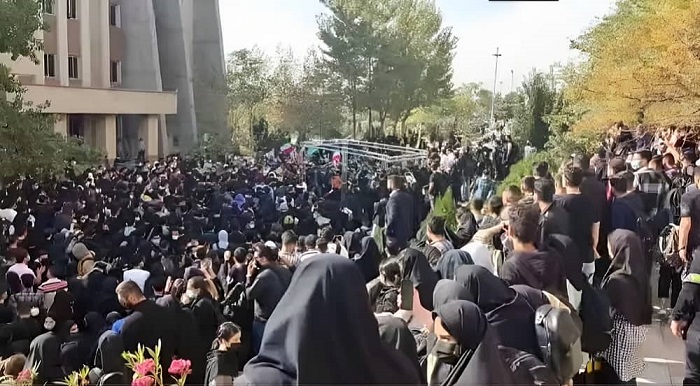

Historically thriving on ignorance and superstition, the governing body now confronts the rising potential of youth-led uprisings with schools and universities in session.
With over 12 million students embarking on their academic journey, flanked by a million dedicated teachers, and an additional 3.3 million commencing their higher education overseen by more than 80,000 professors, the regime is on tenterhooks. Their primary concern is a revival of the public unrest that surged during last year’s uprisings, especially with the backdrop of Ebrahim Raisi’s attempts to portray the regime’s stability at the UN General Assembly.
The 2022 uprising paints a vivid picture of the instrumental role universities played. The martyrdom of Mahsa Amini became a catalyst, especially in Tehran’s academic circles, to propel the revolt. This influence cascaded to school students, particularly female scholars, who took to the streets with vociferous slogans against the Supreme Leader, Ali Khamenei.
Watch our daily recap of #IranProtests2022 Tuesday, October 25
Brave students continued their protests today. #IranRevoIution #MahsaAmini pic.twitter.com/bcc3uirSta— NCRI-FAC (@iran_policy) October 25, 2022
Though initially restrained, the regime’s countermeasures became nefarious as their traditional crackdowns faltered against the organized and united student-front. By November 2022, a malicious wave of poisoning attacks targeted an alarming 280 schools across 28 provinces, all without any claimed responsibility or arrests.
In their desperate bid to suppress this wave of academic rebellion, the regime instituted a multifaceted approach:
– Arresting students on spurious charges and handing down stringent sentences.
– Expelling both students and staff members with any traces of dissent.
– Granting security forces excessive power on campuses.
– Launching chemical attacks on female-centric schools.
– Turning academic institutions into revenue-churning entities.
– Seeding campuses with regime-affiliated members under academic facades.
– Detaining educators on account of uprising affiliations.
– Increasing the quota for militia groups in academic environments.
The daily recap of #IranProtests2022
Sunday, October 23
Today, university students across #Iran continued their demonstrations.
#IranRevoIution2022 #MahsaaAmini pic.twitter.com/3kvgBGEDqY— NCRI-FAC (@iran_policy) October 23, 2022
Khamenei is painfully aware of the challenge the regime faces with an emboldened student body. Therefore, efforts to delay physical university sessions and a push for online classes are on the horizon. Yet, as a unified army of 15.5 million students re-enter academia, the regime recognizes them as a “national security risk.”
As confrontations seem inevitable, the regime’s grasp looks increasingly precarious. With a legacy of four decades of suppression and mass persecution, the ruling body’s attempts to quell the indomitable spirit of Iran’s youth appear futile. The synergy of a new generation, equipped with the weapon of knowledge and driven by resilience, is the looming specter that the archaic regime might find insurmountable.

MEK Iran (follow us on Twitter and Facebook), Maryam Rajavi’s on her site, Twitter & Facebook, NCRI (Twitter & Facebook), and People’s Mojahedin Organization of Iran – MEK IRAN – YouTu







